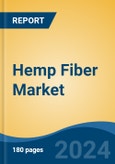Speak directly to the analyst to clarify any post sales queries you may have.
10% Free customizationThis report comes with 10% free customization, enabling you to add data that meets your specific business needs.
The versatility of hemp fibers further drives their popularity. Known for their strength and durability, hemp fibers are utilized in a wide range of industries, including textiles, paper, construction materials, and automotive components. Their ability to adapt to various manufacturing processes ensures their relevance across multiple sectors, promoting innovation and market expansion.
A significant trend reshaping the hemp fiber market is the rise of online retail channels. Consumers are increasingly purchasing hemp-based products, such as clothing, food, personal care items, and supplements, through e-commerce platforms. To capitalize on this trend, manufacturers are forming partnerships with major online retailers like Amazon and eBay to enhance their digital presence and boost sales. Online platforms provide broader reach, especially for smaller manufacturers, and digital marketing strategies, including promotions and consumer engagement via social media, further drive online sales. For instance, according to the U.S. Environmental Protection Agency, hemp-based paints and sealants experienced nearly 30% growth in sales from 2020 to 2022 through major e-retailers, underscoring the critical role online platforms play in the market's expansion.
Key Market Drivers
Rising Demand for Sustainable Materials
As sustainability becomes a core priority globally, the demand for eco-friendly alternatives is driving the resurgence of hemp as a versatile and sustainable material. With heightened environmental awareness, consumers are making conscious decisions to reduce their ecological footprint. Hemp, a crop that requires minimal pesticide and fertilizer use, is gaining popularity as an environmentally responsible option. The textile industry, a major consumer of natural fibers, is undergoing a significant transformation toward sustainable practices. Hemp fibers, which are durable and breathable, are becoming the preferred choice for eco-conscious fashion brands. As the demand for sustainable and ethically sourced textiles increases, the hemp fiber market is experiencing substantial growth.Traditional textile industries, which have long relied on cotton and other resource-intensive fibers, are shifting towards alternatives due to growing concerns about water scarcity and chemical pollution. Hemp, known for its ability to thrive in diverse climates with minimal water and without extensive chemical inputs, provides a compelling solution to reduce dependence on traditional, resource-heavy fibers. For example, data from the U.S. Department of Agriculture’s Economic Research Service shows that certified organic hemp acreage in the U.S. grew from 3,100 acres in 2019 to 15,400 acres in 2022, with states like Colorado, Oregon, and Montana leading the way in organic hemp cultivation.
Key Market Challenges
Misconceptions and Stigma
A significant challenge facing the hemp fiber market is the lingering association with marijuana. Despite hemp containing only trace amounts of THC (the psychoactive compound in marijuana), misconceptions and stigma continue to affect consumer perception. Overcoming these barriers requires extensive education and awareness campaigns to differentiate industrial hemp from its recreational counterpart.Key Market Trends
Integration of Hemp into Mainstream Agriculture
As regulatory landscapes evolve and misconceptions about hemp diminish, an emerging trend is the integration of hemp cultivation into mainstream agriculture. This shift is reshaping agricultural practices globally, with both large-scale producers and smallholders recognizing the economic and environmental advantages of growing hemp. This growing acceptance reflects the increasing potential of hemp to transform industries across the board.Environmentally, hemp offers substantial benefits. Its ability to grow with minimal water and pesticide use reduces pressure on dwindling water resources while mitigating the harmful environmental effects of chemical-intensive farming. Additionally, hemp’s natural ability to improve soil health through phytoremediation provides a sustainable solution to soil degradation, a critical issue in many agricultural regions worldwide.
Key Market Players
- Hempco Food & Fiber Inc
- CBD Biotechnology Co. Ltd
- Ecofibre Ltd
- Hemp Inc
- GenCanna Global, Inc.
- HempFlax BV
- Hemp Oil Canada Inc
- HemPoland Sp. z o.o.
- Dun Agro BV
- Colorado Hemp Works, LLC
Report Scope
This report segments the Global Hemp Fiber Market into the following categories, in addition to discussing the industry trends in detail:
By Source:
- Organic
- Conventional
By Application:
- Food
- Beverages
- Personal Care Products
- Textiles
- Pharmaceuticals
- Others
By Region:
- North America (United States, Canada, Mexico)
- Europe (Germany, United Kingdom, France, Italy, Spain)
- Asia Pacific (China, Japan, India, Australia, South Korea)
- South America (Brazil, Argentina, Colombia)
- Middle East & Africa (South Africa, Saudi Arabia, UAE)
Competitive Landscape
This section provides a detailed analysis of the key companies in the Global Hemp Fiber Market.Available Customizations
TechSci Research offers customized solutions for the Global Hemp Fiber market report to address specific business needs. • Detailed analysis and profiling of additional market players (up to five).This product will be delivered within 1-3 business days.
Table of Contents
Companies Mentioned
- Hempco Food & Fiber Inc
- CBD Biotechnology Co Ltd
- Ecofibre Ltd
- Hemp Inc
- GenCanna Global, Inc.
- HempFlax BV
- Hemp Oil Canada Inc
- HemPoland Sp. z o.o.
- Dun Agro BV
- Colorado Hemp Works, LLC
Table Information
| Report Attribute | Details |
|---|---|
| No. of Pages | 180 |
| Published | February 2025 |
| Forecast Period | 2024 - 2030 |
| Estimated Market Value ( USD | $ 378.56 Million |
| Forecasted Market Value ( USD | $ 561.8 Million |
| Compound Annual Growth Rate | 7.0% |
| Regions Covered | Global |
| No. of Companies Mentioned | 10 |









